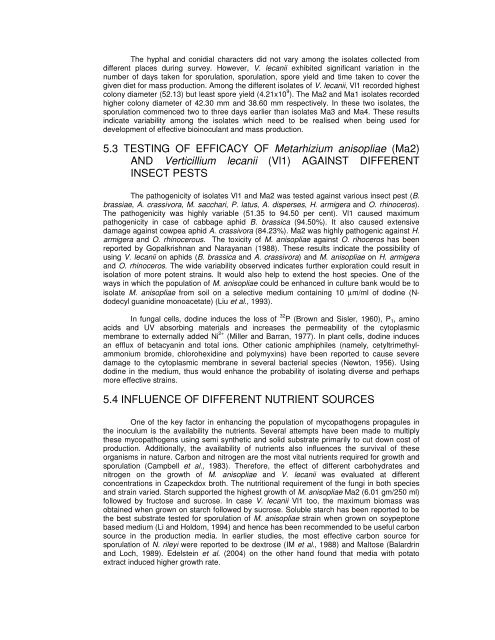ISOLATION AND CHARACTERIZATION OF ENTOMOPATHOGENIC ...
ISOLATION AND CHARACTERIZATION OF ENTOMOPATHOGENIC ...
ISOLATION AND CHARACTERIZATION OF ENTOMOPATHOGENIC ...
You also want an ePaper? Increase the reach of your titles
YUMPU automatically turns print PDFs into web optimized ePapers that Google loves.
The hyphal and conidial characters did not vary among the isolates collected from<br />
different places during survey. However, V. lecanii exhibited significant variation in the<br />
number of days taken for sporulation, sporulation, spore yield and time taken to cover the<br />
given diet for mass production. Among the different isolates of V. lecanii, Vl1 recorded highest<br />
colony diameter (52.13) but least spore yield (4.21x10 9 ). The Ma2 and Ma1 isolates recorded<br />
higher colony diameter of 42.30 mm and 38.60 mm respectively. In these two isolates, the<br />
sporulation commenced two to three days earlier than isolates Ma3 and Ma4. These results<br />
indicate variability among the isolates which need to be realised when being used for<br />
development of effective bioinoculant and mass production.<br />
5.3 TESTING <strong>OF</strong> EFFICACY <strong>OF</strong> Metarhizium anisopliae (Ma2)<br />
<strong>AND</strong> Verticillium lecanii (Vl1) AGAINST DIFFERENT<br />
INSECT PESTS<br />
The pathogenicity of isolates Vl1 and Ma2 was tested against various insect pest (B.<br />
brassiae, A. crassivora, M. sacchari, P. latus, A. disperses, H. armigera and O. rhinoceros).<br />
The pathogenicity was highly variable (51.35 to 94.50 per cent). Vl1 caused maximum<br />
pathogenicity in case of cabbage aphid B. brassica (94.50%). It also caused extensive<br />
damage against cowpea aphid A. crassivora (84.23%). Ma2 was highly pathogenic against H.<br />
armigera and O. rhinocerous. The toxicity of M. anisopliae against O. rihoceros has been<br />
reported by Gopalkrishnan and Narayanan (1988). These results indicate the possibility of<br />
using V. lecanii on aphids (B. brassica and A. crassivora) and M. anisopliae on H. armigera<br />
and O. rhinoceros. The wide variability observed indicates further exploration could result in<br />
isolation of more potent strains. It would also help to extend the host species. One of the<br />
ways in which the population of M. anisopliae could be enhanced in culture bank would be to<br />
isolate M. anisopliae from soil on a selective medium containing 10 µm/ml of dodine (Ndodecyl<br />
guanidine monoacetate) (Liu et al., 1993).<br />
In fungal cells, dodine induces the loss of 32 P (Brown and Sisler, 1960), P1, amino<br />
acids and UV absorbing materials and increases the permeability of the cytoplasmic<br />
membrane to externally added Ni 2+ (Miller and Barran, 1977). In plant cells, dodine induces<br />
an efflux of betacyanin and total ions. Other cationic amphiphiles (namely, cetyltrimethylammonium<br />
bromide, chlorohexidine and polymyxins) have been reported to cause severe<br />
damage to the cytoplasmic membrane in several bacterial species (Newton, 1956). Using<br />
dodine in the medium, thus would enhance the probability of isolating diverse and perhaps<br />
more effective strains.<br />
5.4 INFLUENCE <strong>OF</strong> DIFFERENT NUTRIENT SOURCES<br />
One of the key factor in enhancing the population of mycopathogens propagules in<br />
the inoculum is the availability the nutrients. Several attempts have been made to multiply<br />
these mycopathogens using semi synthetic and solid substrate primarily to cut down cost of<br />
production. Additionally, the availability of nutrients also influences the survival of these<br />
organisms in nature. Carbon and nitrogen are the most vital nutrients required for growth and<br />
sporulation (Campbell et al., 1983). Therefore, the effect of different carbohydrates and<br />
nitrogen on the growth of M. anisopliae and V. lecanii was evaluated at different<br />
concentrations in Czapeckdox broth. The nutritional requirement of the fungi in both species<br />
and strain varied. Starch supported the highest growth of M. anisopliae Ma2 (6.01 gm/250 ml)<br />
followed by fructose and sucrose. In case V. lecanii Vl1 too, the maximum biomass was<br />
obtained when grown on starch followed by sucrose. Soluble starch has been reported to be<br />
the best substrate tested for sporulation of M. anisopliae strain when grown on soypeptone<br />
based medium (Li and Holdom, 1994) and hence has been recommended to be useful carbon<br />
source in the production media. In earlier studies, the most effective carbon source for<br />
sporulation of N. rileyi were reported to be dextrose (IM et al., 1988) and Maltose (Balardrin<br />
and Loch, 1989). Edelstein et al. (2004) on the other hand found that media with potato<br />
extract induced higher growth rate.
















